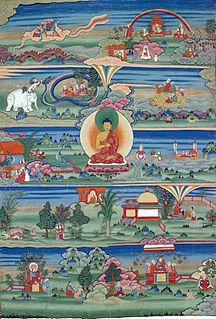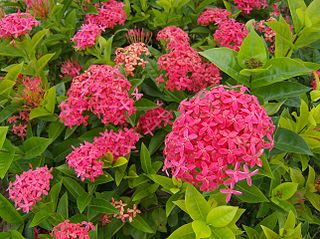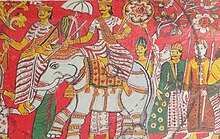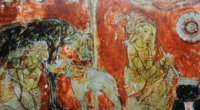
Theravada Buddhism is the State religion of Sri Lanka practiced by 70.2% of the Sri Lanka's population. Buddhism has been given special privileges in the constitution and also declared country's official religion by 2nd president of sri Lanka J.R Jayawardene. Sri Lanka is traditionally oldest religious Buddhist country where Buddhist aryan culture is protected and preserved. The island has been a center of Buddhist scholarship and learning since the introduction of Buddhism in the third century BCE producing eminent scholars such as Buddhaghosa and preserving the vast Pāli Canon. Throughout most of its history, Sri Lankan kings have played a major role in the maintenance and revival of the Buddhist institutions of the island. During the 19th century, a modern Buddhist revival took place on the island which promoted Buddhist education and learning. There are around 6,000 Buddhist monasteries on Sri Lanka with approximately 15,000 monks.
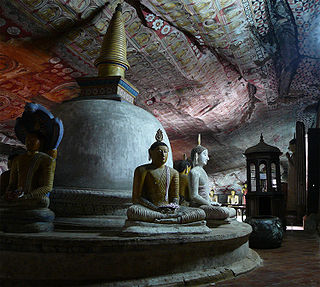
Dambulla cave temple also known as the Golden Temple of Dambulla is a World Heritage Site (1991) in Sri Lanka, situated in the central part of the country. This site is situated 148 kilometres (92 mi) east of Colombo and 72 kilometres (45 mi) north of Kandy.

Yapahuwa was one of the ephemeral capitals of medieval Sri Lanka. The citadel of Yapahuwa lying midway between Kurunagala and Anuradhapura was built around a huge granite rock rising abruptly almost a hundred meters above the surrounding lowlands.

Eight sites of Sri Lanka have been inscribed in the UNESCO World Heritage, namely, the ancient city of Polonnaruwa (1982), the ancient city of Sigiriya (1982), the Golden Temple of Dambulla (1991), the old town of Galle and its fortifications (1988), the sacred city of Anuradhapura (1982), the sacred city of Kandy (1988), Sinharaja Forest Reserve (1988) and the Central Highlands of Sri Lanka (2010).
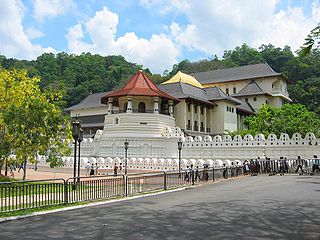
Sri Dalada Maligawa or the Temple of the Sacred Tooth Relic is a Buddhist temple in the city of Kandy, Sri Lanka. It is located in the royal palace complex of the former Kingdom of Kandy, which houses the relic of the tooth of the Buddha. Since ancient times, the relic has played an important role in local politics because it is believed that whoever holds the relic holds the governance of the country. Kandy was the last capital of the Sri Lankan kings and is a World Heritage Site mainly due to the temple.

The Statue of Tara is a gilt-bronze sculpture of the Tara that dates from the 7th-8th century AD in Sri Lanka. Taken by force from the last King of Kandy when the British annexed Kandy in the early nineteenth century, it was given to the British Museum in 1830 by the former British Governor of Ceylon, Sir Robert Brownrigg.

The Aluvihare Rock Temple is a sacred Buddhist temple located in Aluvihare, Matale District of Sri Lanka. Surrounded by hills, the Aluvihara cave temple is situated 30 km north of Kandy on the Matale-Dambulla road. The history of Aluvihare Rock Temple is traced back to the 3rd Century B.C to the reign of King Devanampiyatissa. It is believed that the King built the dagoba, planted the Bo sapling and founded the temple after the introduction of Buddhism to the country during his reign.
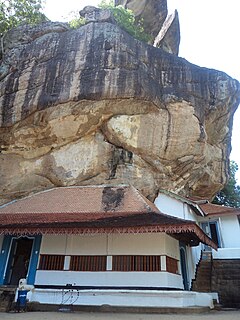
Ridi Viharaya or Silver Temple is a 2nd-century BCE Theravada Buddhist temple in the village of Ridigama, Sri Lanka. Built during the reign of Dutthagamani of Anuradhapura, the temple is considered as the place where the silver ore, which provided silver to complete Ruwanwelisaya; one of the largest stupa in Sri Lanka, was discovered. According to the chronicles Mahavamsa and Thupavamsa, the Ridi Viharaya complex was built in gratitude for helping him cherish his dream of completing Ruwanwelisaya.

Gate Mudaliyar Jeronis de Soysa was a pioneering Ceylonese entrepreneur and philanthropist. He was a pioneer coffee planter and an industrialist who became the wealthiest Ceylonese of the 19th century by establishing the largest native commercial enterprise of the era. He was instrumental in the establishment of the first Ceylonese bank and is often referred to as a father of private enterprise in British Ceylon. He was the first Mudaliyar to be elevated in recognition of his philanthropy.

Bellanwila Rajamaha Viharaya is a Buddhist temple situated in Bellanwila, Colombo District, Sri Lanka. Located around 12 km south to the Colombo city, near Dehiwala - Maharagama road, the temple attracts hundreds of devotees daily and is famous for its annual Esala Perehera festival which usually takes place in the month of August or September. One of the most venerated Buddhist temples in Sri Lanka, many devotees flock to worship the sacred Bo tree of Bellanwila Rajamaha Vihara, which is considered to be one of the first offshoots of Jaya Sri Maha Bodhi in Anuradhapura, Sri Lanka. The present chief incumbent of Bellanwila Rajamaha Vihara is Ven. Bellanwila Dhammaratana Nayaka Thera.
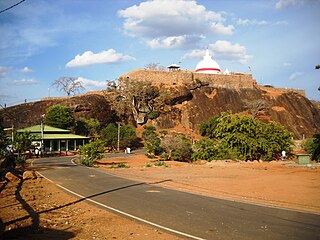
Sithulpawwa Rajamaha Viharaya is an ancient Buddhist monastery located in Hambantota District, South Eastern Sri Lanka. Situated 18 km east of the pilgrimage town Katharagama, it is believed to have been built in the 2nd century B.C by king Kavantissa. Sithulpawwa Vihara can be reached by travelling 18 miles along the Tissamaharama-Yodhakandiya road towards the Yala National Park. The name Sithulpawwa is derived from the word "Chiththala Pabbatha", which means the hill of the quiet mind.
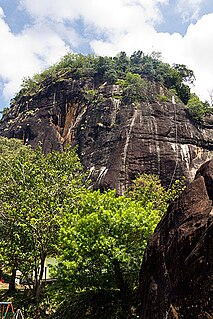
Mulkirigala Raja Maha Vihara is an ancient Buddhist temple in Mulkirigala, Sri Lanka. It has been built on a 205 m (673 ft) high natural rock, surrounded with another four rocks known as Benagala, Kondagala, Bisogala and Seelawathiegala. The temple site is located about 2 km (1.2 mi) from the Mulkirigala junction and can be reached from either Dikwella or Tangalle towns. The temple has been formally recognised by the Government as an archaeological site in Sri Lanka. The designation was declared on 8 April 1988 under the government Gazette number 501.

Naigala Rajamaha Viharaya is an ancient Buddhist temple situated in Weeraketiya, Hambantota District, Sri Lanka. It is located about 2 km (1.2 mi) away from Weeraketiya junction and 8 km (5.0 mi) from ancient Buddhist temple, Mulkirigala Raja Maha Vihara.

Warana Raja Maha Vihara is an ancient Buddhist temple which is situated in Thihariya, Gampaha District, Sri Lanka. The temple is located approximately 5 km (3.1 mi) away from the Colombo - Kandy highway.Currently this temple has been recognized as an archaeological protected site in Gampaha District by Archaeological department.

Gadaladenyia Vihara is an ancient Buddhist temple situated in Pilimathalawa, Kandy, Sri Lanka. It is located on Gadaladenyia Road (B116), just up from the Gadaladeniya junction of the Colombo - Kandy Road (A1), approximately 12.5 km (7.8 mi) to the west of Kandy and 3 km (1.9 mi) from the ancient buddhist temple, Lankatilaka Vihara. It is considered one of the largest rock temples in Sri Lanka.

Degaldoruwa Raja Maha Vihara is an ancient Buddhist rock temple, situated in Amunugama, Kandy, Sri Lanka. It is famous for its Kandyan Era Frescoes. The cave itself was said to have been excavated out of a rock which rises to a height of approximately 12.3 m (40 ft), and shelters the shrine room and entrance chamber.
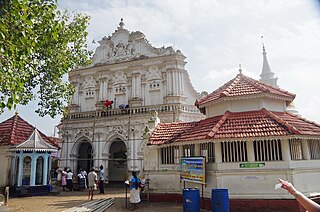
Kande Vihara is a major Buddhist temple in Kalutara District, Sri Lanka. The temple has got its name 'Kande vihara' as it is built on top of a hill located near to Aluthgama town. The temple has been formally recognised by the Government as an archaeological site in Sri Lanka.
Buddama Raja Maha Vihara is a historic Cave temple in Buddama village, Monaragala district, Sri Lanka. Buddama is a rural village lying off Siyambalanduwa town and known as one of early settlements in the country. Currently the temple has been formally recognised by the Government as an archaeological site in Sri Lanka.

Aramanapola Raja Maha Vihara or Ganegama Rankoth Vihara is an ancient Buddhist temple in Ganegama, Sri Lanka. The Vihara is located approximately 2.5 km (1.6 mi) far away from the Pelmadulla town on Colombo - Batticaloa main road (A4). The temple has been formally recognised by the Government as an archaeological site in Sri Lanka. The designation was declared on 2 March 1951 under the government Gazette number 10217.
Asgiri Maha Viharaya is a Buddhist monastery located in Kandy, Sri Lanka. It is the headquarters of the Asgiriya chapter of Siyam Nikaya, one of the two Buddhist monasteries that holds the custodianship of sacred tooth relic of Lord Buddha kept in Sri Dalada Maligawa, Kandy. The chief incumbent of the Asgiri Maha Viharaya is the Mahanayaka thero of Asgiri chapter of Siyam nikaya, a leading Buddhist monastic fraternity in Sri Lanka. The present chief incumbent of Asgiri Maha Viharaya is venrable Warakagoda Sri Gnanarathana Thero. Asgiri Maha Vihara traces its origin from the wanavasi sect of the Dimbulagala forest monastery of Polonnaruva. Currently 565 Buddhist temples in Sri Lanka functions under Asgiri Viharaya of Kandy.






